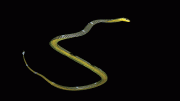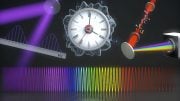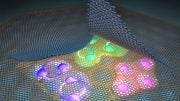
Researchers from UPV, UPC, and ICFO have discovered “Photonic snake states,” marking a significant advancement in the study of light and its manipulation. The finding, published in Nature Photonics, opens up new possibilities in the formation of frequency combs and paves the way for advanced applications in fields like communication, spectroscopy, metrology, and quantum computing.
Researchers from UPV, UPC, and ICFO, in Spain, discover photonic snakes, a new instrument for unveiling the secrets of light.
Light, with its myriad colors, is one of nature’s wonders. Truly comprehending what we observe requires us to understand the precise colors of the light shaping our perception. We accomplish this through the use of optical tools known as frequency combs, which were first recognized with a Nobel Prize in Physics in 2005.
These optical rulers are utilized not only for measuring colors but also time, distance, and other critical quantities. As such, they play a crucial role in scientific and technological applications, enabling us to explore and uncover the profound mysteries of light.
Recently, a study led by the Universitat Politècnica de València (UPV), featuring researchers from the Universitat Politècnica de Catalunya – Barcelona Tech (UPC) and the Institute of Photonic Sciences (ICFO), has achieved a breakthrough. The team’s work, published in the scientific research journal Nature Photonics, unveiled a new tool called “Photonic snake states” for deciphering light’s secrets.
The study has captivated the international scientific community and has opened up unparalleled possibilities in frequency comb formation. It postulates the existence of two-dimensional optical rulers, which are more complex than the one-dimensional versions currently in use, and provide exceptional versatility across various applications.

Photonic micro-cylinder in the photonic snake generation regime. Credit: UPV
Applications in communications, spectroscopy, or computing
Frequency combs have a plethora of applications, particularly in the field of communications. The authors of the study suggest that these combs enable the efficient transmission of substantial amounts of information via optical fibers. By utilizing well-defined frequencies, multiple light signals can be sent simultaneously and easily separated when they are received.
Frequency combs also play a pivotal role in spectroscopy. They allow optical spectra to be obtained with unmatched accuracy and resolution, facilitating the identification of different substances. This is particularly useful in chemistry, biology, and medicine where precise molecule detection and material characterization are crucial.
In metrology, the science of measurement, these structures serve as reference standards due to their capacity to generate stable and known frequencies. They enable exact measurements of fundamental quantities like time and length, which are essential in most scientific domains.
In addition, frequency combs have shown promising potential in quantum computing. Here, light particles or photons are integral. Specifically, frequency combs can generate single photons with unique properties, essential for advancing these technologies.
The future of optical rules
However, the development of these optical rulers faces a fundamental challenge: the instabilities that occur when constructing them. These instabilities hinder the generation of versatile light forms.
As Professor Pedro Fernández de Córdoba, researcher at the UPV’s IUMPA and co-author of this work, points out, “it should be noted that our team has obtained, from a theoretical point of view, the conditions for the light structure to be stable, finding zigzag-shaped configurations that we have called Photonic Snakes. The stability of these light states is a crucial aspect of future applications.”
The study also demonstrated the feasibility of creating a two-dimensional arrangement of individually accessible, synchronized optical rulers. This breakthrough allows for a vast array of rules to be generated in a single device, controlled by a single laser light source.
In fact, as Prof. Carles Milián, who led this research, says: “The potential impact of this breakthrough is extraordinary, as it could enable the development of broadband, reconfigurable, monolithic multicomb devices. These devices would provide different frequency combs on demand and in real-time, significantly expanding existing applications.”
Moreover, this study is grounded in thorough and comprehensive theoretical models. These have taken into account all known effects that could surface in future experiments on two-dimensional frequency comb formation, using robust theoretical and numerical tools.
In fact, as Professor J. Alberto Conejero, Director of UPV’s Department of Applied Mathematics and co-author of this work, points out, “this research has built a very precise model that includes all the phenomena that can influence the formation of these structures. It will function as a guide for future experiments, with the consequent economic impact of knowing in advance the experimental parameters with which stable light snakes can be generated.”
Scientific milestone
This discovery marks a milestone in the physics of these structures and paves the way for an “exciting future of advanced optical devices”. Salim B. Ivars (Universitat Politècnica de Catalunya), Yaroslav V. Kartashov and Lluís Torner (ICFO) have also contributed to the work. According to the latter, “this important discovery is remarkable for being unexpected and surprising, and has been possible thanks to the intuition and leadership of Professor Milián.”
The UPV, UPC, and ICFO team says this finding will further stimulate research in this field and lead to revolutionary new applications and technologies. “Thanks to these advances, we are one step closer to unraveling the mysteries of light and harnessing its full potential for the benefit of our society,” they conclude.
Reference: “Photonic snake states in two-dimensional frequency combs” by Salim B. Ivars, Yaroslav V. Kartashov, P. Fernández de Córdoba, J. Alberto Conejero, Lluis Torner and Carles Milián, 29 May 2023, Nature Photonics.
DOI: 10.1038/s41566-023-01220-1









Deleting comments is the fear of Pseudoscience Behavior to Scientific Thought. Don’t worry, science is not afraid of being questioned.
Best wishes to you all.